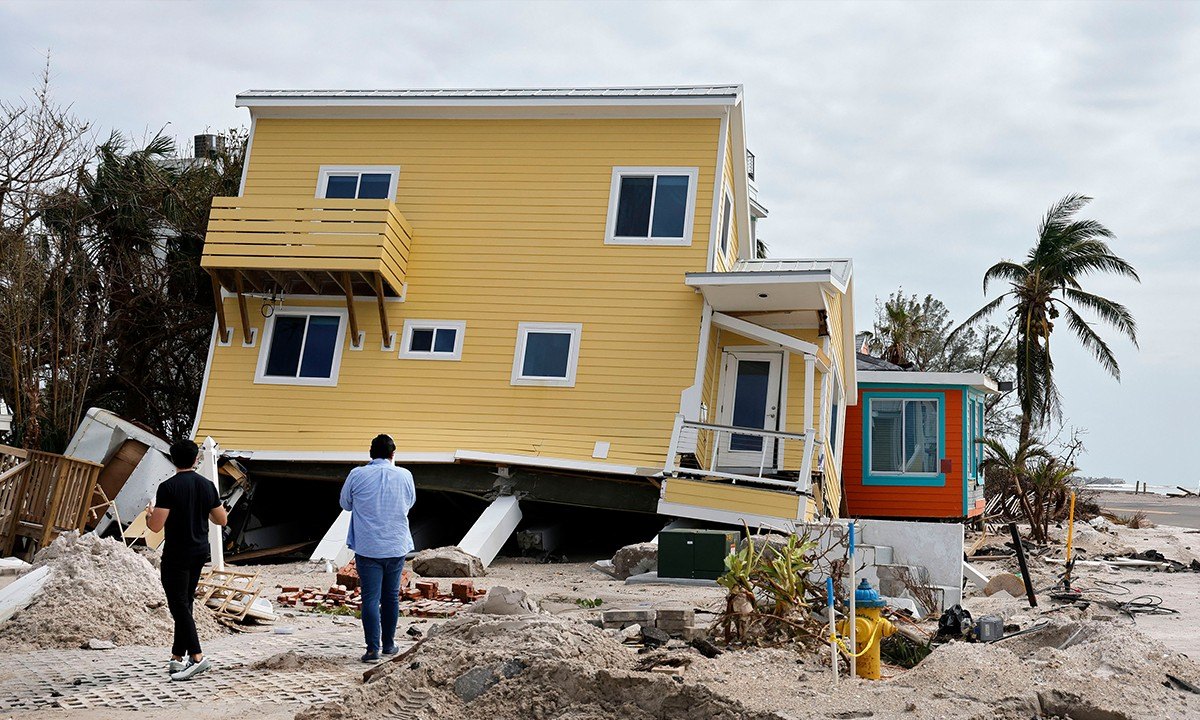Millions of Americans Live in ‘Insurance Deserts’—but There Are Ways To Protect Your Home


Getty Images
Homeowners insurance has doubled for some Americans. For others, it’s out of reach due to climate risks, leaving millions living in “insurance deserts.”
Florida-based website designer Angela Hudgens tells Realtor.com® that her insurance has gone from about to $2,000 per year to close to $4,000.
“There’s a giant bump at every renewal, and you can barely afford to pay it,” she says. “I’m really worried about these increasing costs because I know extreme weather hazards are only getting worse.”
Hudgens adds that even though she tries to negotiate lower rates, “every provider keeps raising their prices so there’s little relief here.”
Nearly half of all homes in the U.S., 44.8%, are at risk of severe or extreme damage from environmental threats, according to a report from the Realtor.com economics team. Almost $22 trillion in residential real estate is in danger of flooding, wind damage, wildfires, heat, or hazardous air quality.
And it’s causing insurers to raise their premiums or back out entirely from some markets. More than 30 home insurance companies have exited the state of Florida, according to Bankrate, making the market more expensive and less competitive.
Hudgens, like the vast majority of homeowners, has a mortgage on her property so is unable to drop her insurance. And even if she could, she’d be too afraid to do so.
“I want there to be a reform or something to keep the market in check because it’s just no longer working for many of us,” she says.
Former Florida Sen. Jeff Brandes is trying to make that happen. He founded The Florida Policy Project, a nonprofit that encourages the legislature to adopt best practices from across the country in areas such as insurance and housing.
“Since 2023, Florida insurance consumers have continued to face challenges due to rate increases, largely caused by inflation, labor shortages, and rising material costs—issues shared by many other states,” Brandes says. “Affordability is the No. 1 issue in Florida today.”
Sky-high premiums across America
But Florida isn’t the only state that’s facing rising premiums.
Property insurance premiums in the U.S. have risen by more than 30 percent across the board since 2020.
As a result of extreme weather events, premiums are spiking in states like California, Louisiana, North Carolina, Texas, Wyoming, and Oklahoma.
“It’s tempting to think ‘I don’t live in Florida or California so I’ll be fine,’ but the truth is this is a national problem,” says Max Dugan-Knight, a climate data scientist at Deep Sky, a carbon removal project developer working to reverse climate change. “There are no ‘climate havens’ because risks are growing everywhere.”
In Colorado, real estate investor Brian Rudderow, of HBR Colorado, is feeling the crunch.
He recently received a quote for a property in Colorado Springs at $13,000 per year, which was much higher than he anticipated.
“I’m extremely concerned about the rising costs, and it’s very discouraging,” he says.
Rudderow is currently leaving his property uninsured for the time being.
“Though Colorado may not be the first state that comes to mind when you think of extreme weather—even I think of Florida first!—the reality is that we do experience extreme weather here and have higher risks for wildfires, high winds, hail storms, and more,” says TurboTenant CEO Seamus Nally, who lives in Fort Collins, CO. “That has led insurance costs to rise quite a bit these past few years, as weather in general has gotten worse.”
‘Insurance deserts’ on the rise
Many states are becoming “insurance deserts,” where “increased risk and high claim costs are causing insurance companies to pull back or stop writing policies entirely,” says Leslie Kasperowicz, executive editor for Insurance.com.
Along with Florida, California has seen seven of its 12 largest home insurance companies leave the state, and at least 12 major companies fled the Louisiana market after four hurricanes in 2020 and 2021.
As extreme weather ramps up, insurers are starting to exit other states as well.
“We are seeing some property insurance availability issues in Colorado and coastal areas of the Carolinas due to escalating climate risks and home insurers reducing their risk exposure in these areas,” says Mark Friedlander, director of corporate communications at the Insurance Information Institute.
Nationwide did not renew around 10,000 policies in North Carolina last year due in part to risks posed by climate change and hurricanes.
And major insurers in several Western states—including Washington, Oregon, and Idaho—have dramatically pulled back as “the frequency of extreme wildfire risk has grown 20 times nationwide,” says Dugan-Knight.
Insurers are also fleeing states like Texas, New York, and Hawaii due to extreme weather risk.
Yet, all hope is not lost.
“Regulators are working to bring insurers back into tough markets, and insurance companies are correcting course,” says Kasperowicz. “However, a big part of the correction is raising rates to match the risk, so I think we’ll likely see rates stay high.”
In California, for example, homeowners living in high fire-risk areas have struggled to get insurance. But under new rules, state insurers will, for the first time, be allowed to use a “catastrophe model” to help determine the cost of home insurance. These models aim to determine the risk a structure faces from wildfires, according to the Los Angeles Times.
When premiums become dealbreakers
Homeowners have historically depended on relatively stable monthly housing costs from one year to the next, but rising home insurance rates have made that nearly impossible these days.
“As home insurance costs continue rising, homeowners will need to plan for those bigger increases in their monthly expenses,” says Cassie Sheets, a data journalist at Insurify in Cambridge, MA.
How significant will those increases be? Aidan Charron, associate director of Global Earth Day at EarthDay.org, says, “I think rates are going to increase to a level that will make it impossible for many to afford.”
Would-be homebuyers are crunching the numbers now more than ever.
“Buyers are absolutely taking into consideration the cost of insurance when buying a home in this current climate—including homeowners insurance, flood insurance, earthquake insurance, and fire insurance,” says Cara Ameer, a real estate agent with Coldwell Banker in Florida and California.
And if the math doesn’t make sense, many are willing to walk away—which is something real estate agent Sam Fitz-Simon, with Compass in Danville, CA, has experienced firsthand.
“I have had a client decide against a property solely based on the fact that the insurance options were too expensive,” he says.
And that client is not alone. In 2024, over 13% of real estate agents in California experienced canceled sales transactions because their clients were unable to secure insurance, according to the California Association of Realtors.
“In some areas of California, no insurance companies will be willing to quote you at all,” says Jameson Tyler Drew, president of Anubis Properties in Los Angeles.
What to do if you can’t get insurance
If you can’t find an insurance company that will issue you a policy, it’s time to look into what’s called “insurers of last resort.”
These are government-backed insurance programs designed to offer coverage for properties that are hard or impossible to insure through the private market.
Thirty-three states and Washington, DC, currently have a Fair Access to Insurance Requirements (FAIR) Plan. Colorado will launch its next year.
“The Colorado FAIR Plan is expected to offer coverage to approximately 29,000 homes in 2025, which represents roughly 1% of the state’s properties, primarily located in wildfire-prone mountain regions,” says Friedlander.
In the Carolinas, coverage gaps are also being filled by excess and surplus lines carriers, “which are insurers that offer coverage to homeowners when standard options are not available,” says Friedlander. “This is common in high-risk, coastal communities prone to hurricanes.”
What homeowners can do
Due to intensifying climate change, the number of insurance companies pulling out from high-risk areas could double or even triple in the coming years, according to Alex Adekola, CEO and founder of insurance adjuster training company ReadyAdjuster.
Which regions are most vulnerable? According to Earth Day’s Charron, “First it’ll be the areas most affected by extreme weather such as the Southeast from increased dangerous storms and the West due to an increase in wildfires. Soon, areas will start drying up from increased temperatures and will be deemed uninsurable.”
For now, consulting an independent insurance agent can help “since these professionals often have access to a variety of different carriers,” Adekola explains. “Also, you can speak with them more closely so they’d be able to guide you to policies and insurers that would best suit your needs based on your specific situation.”
However, the most actionable thing you can do right now is to make sure that your home is resilient enough to reduce risks and make it more insurable, according to Adekola.
“For example, if you live in an area prone to wildfires, invest in fire-resistant roofing,” he advises.
Depending on where you live, there are many things you can do to prepare for extreme weather before it happens, to mitigate your risks.
“Adapting your home to climate change is key,” says Adekola.
All climate risks—including wildfire, flood, air quality, extreme heat, and severe winds—are listed in the Environmental Risk section of individual property listings on Realtor.com. When searching for a home, you can also apply a map filter to view the risk in a particular area.
Categories
Recent Posts











"My job is to find and attract mastery-based agents to the office, protect the culture, and make sure everyone is happy! "
